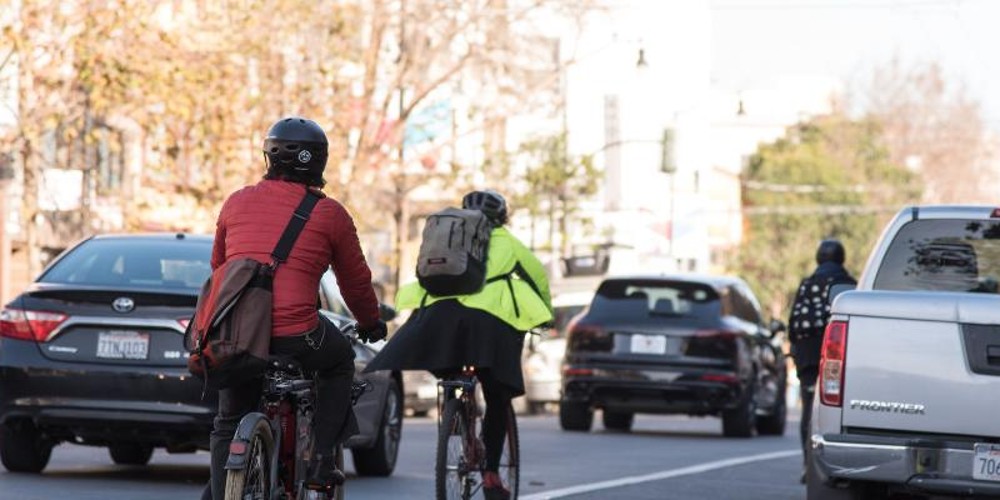In April 2023, the SF Municipal Transportation Agency (SFMTA) Board of Directors will be voting to approve a center-running bike lane pilot on Valencia Street between 15th to 23rd Streets for 18-months.
Your SF Bicycle Coalition supports the approval of this pilot because we need to improve safety along 15th and 23rd Streets now. This pilot is ready to be implemented and studied, then adapted as we learn its effectiveness. We can’t risk losing another life when we have an opportunity to make things safer for our most vulnerable road users — people walking, biking, and rolling.
Valencia Street is one of the most critical north and south bike routes that connect people from the southeast to the Mission to downtown. Making this street safer for our city’s most vulnerable users has been a longstanding issue since the ‘90’s when our then-Membership Manager, Mary Brown, led the initial campaign for bike lanes along the corridor. For over a decade, we have been working on safety improvements to Valencia with the city, our members, and the larger community. From successfully advocating for parking protected bike lanes between Market to 15th, to almost piloting protected bike lanes between 19th to Cesar Chavez in 2020, we now have an opportunity to close the gap. Creating immediate safety for people walking, biking, and rolling on Valencia is our priority.
While we have unresolved concerns about the ultimate effectiveness of the center-running bike lane, we are excited about some elements of this project, including the restrictions on double parking, the left-turn restrictions, and more robust delineation materials like K71 bollards and 4-inch high rubber curbs that are stronger than typical soft-hit posts. Leaving the existing conditions on Valencia as they are would be dangerous for all users. With limited design options and immediate urgency to improve safety now, piloting this design and studying what works and what doesn’t is a reasonable step forward.
Caption: Example of K71 Bollards
40% of all collisions in the project area are between vehicles and bicycles — most commonly as the result of unsafe turns, lane changes, and dooring by vehicles. 22% of all collisions in the project area are between vehicles and people walking, the most common reason being a vehicle failing to yield at a crosswalk.
There is an urgent need for Valencia to receive immediate safety improvements. In 2020, we were advocating to improve street conditions between 19th and Cesar Chavez. Due to local opposition and lack of community engagement, the project could not move forward, thus leaving zero protection for those walking, biking, and rolling along this stretch for the last three years.
If approved, during the 18-month pilot SFMTA will be evaluating the metrics below and will present them to the SFMTA Board of Directors at a hearing in December to decide how to move forward if the pilot is not improving safety.
- Behavior:
- User compliance with new traffic restrictions and traffic control devices, such as corridor-wide left-turn restrictions and new bicycle signals.
- Vehicle speeds
- Bicycle and pedestrian conflicts at intersections
- Effective Design:
- Traffic collisions
- Vehicle loading behavior
- Bicycle positioning along the street
- Bikeway ease of access
- Emergency vehicle interaction with the bikeway
- Mobility
- Bicycle and vehicle volumes both pre-and post-implementation to determine significant changes in mode shift. Mode-shift, especially changes in bicycle volumes, are an indicator to assess comfort of use with transportation facilities.
- Impacts of left turn restrictions on neighborhood circulation
In addition to the pilot, the SFMTA has committed to using Neighborhood Transportation Improvement Program (NTIP) funding to study and compare three long-term design options for the entire corridor, including curbside protected bike lanes (studies of which are already completed), a two-way cycle track on one side of the street, and future pedestrianization of particular blocks. If approved, the center-running bike lane evaluation and the NTIP studies will be completed by the end of 2024, giving us more design options to choose from for long-term Valencia Street.
As part of our recommendation for this plan to be approved, we need the SFMTA to provide additional messaging and collateral to educate the public on how to use this new type of street design for people biking and driving along the corridor. Additionally, we urge SFMTA to conduct a more inclusive outreach process to Mission communities while the pilot is in the ground and the NTIP studies take place.
Last year was our deadliest year of traffic fatalities in over a decade. With our 2024 Vision Zero deadline quickly approaching, safety cannot wait any longer. With an average of 26 collisions annually along this stretch, we believe a center-running bike lane is a step towards safety and is better than leaving the corridor the way it is now. We look forward to the completion of the NTIP studies in 2024 and to work with SFMTA, merchants, advocates, and residents to design the future of Valencia Street.


